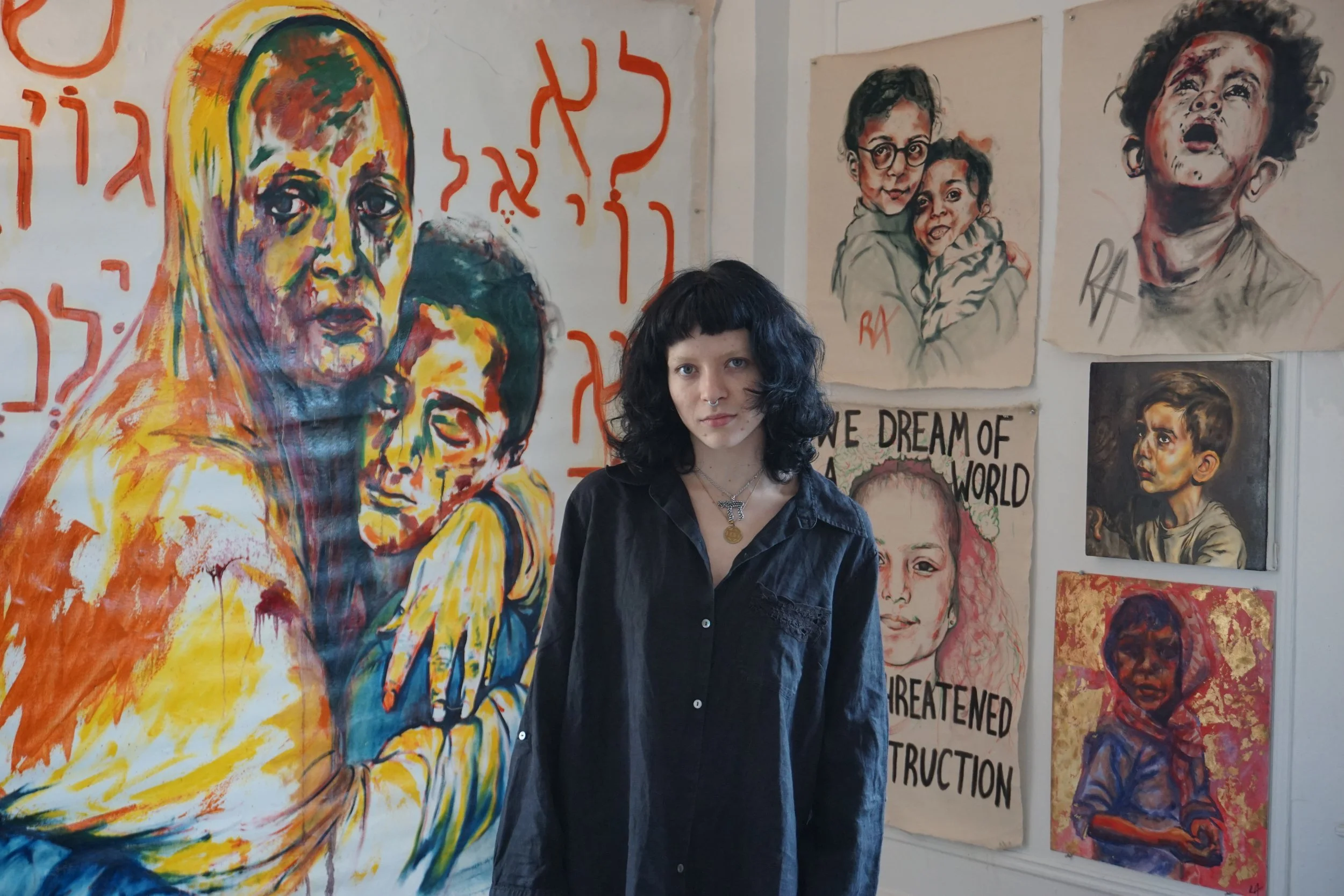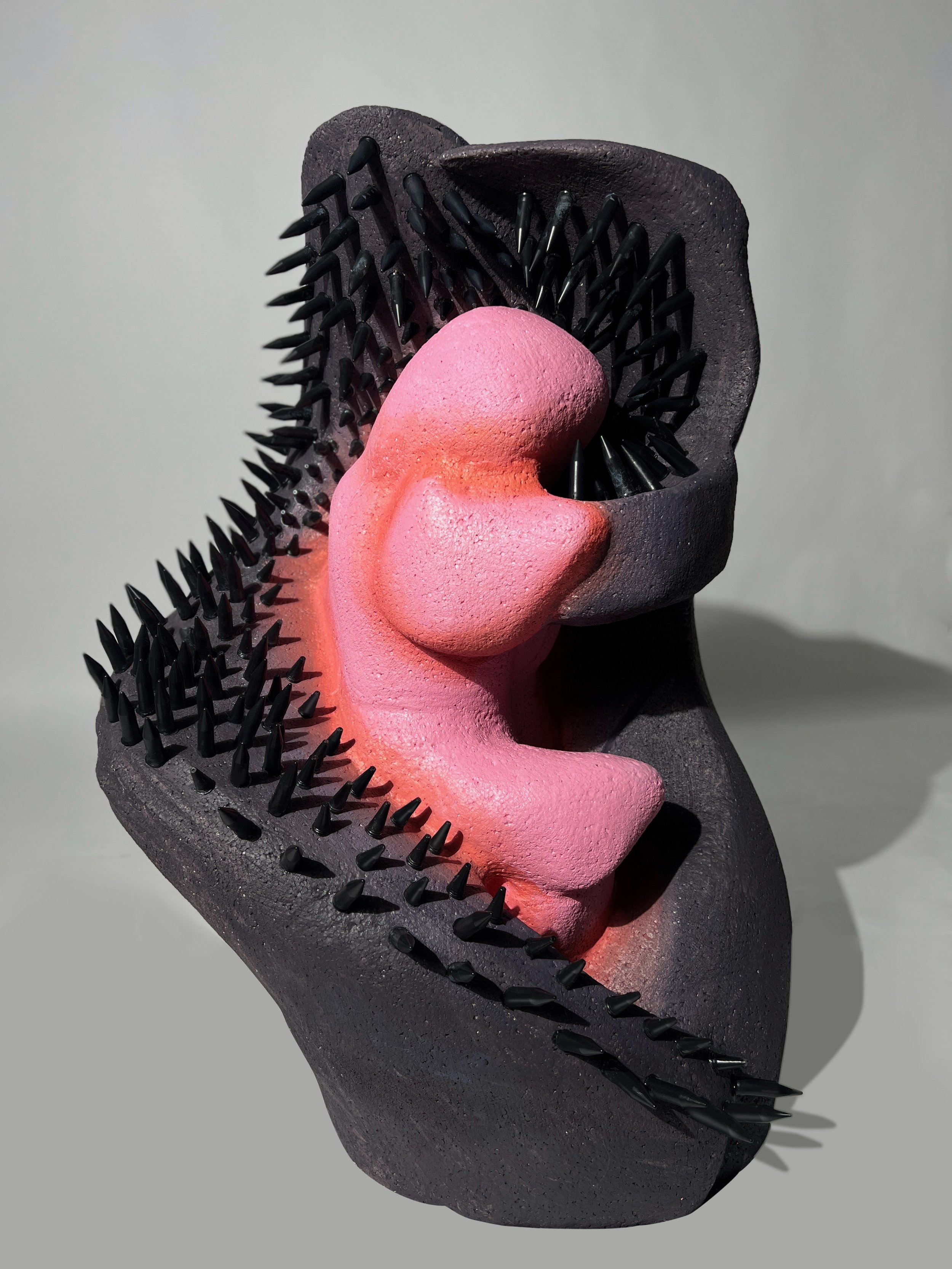Feature by Anushka Pai
Photos by Alicia Tang
Lixin Yan is a sophomore (‘27) at Barnard College studying art history, visual arts, and psychology. While her primary discipline is fashion design, her portfolio includes sculptures, photography, drawings, and paintings. We met on the Diana patio, easing into our conversation soon after.
Lixin begins her creative process with rumination—pulled towards ideas that are particularly hard to process. As such, her work tackles diverse subjects, be it grief or political turmoil. Two of her recent projects, “The Mirror of Erised” and “Survival of the Fittest,” were inspired by the pain she experienced while navigating an emotional breakup.
In a period of loss, change, and coping, Lixin’s turmoil began to bleed into her subconscious.
“I have a lot of nightmares and I draw all of them. Immediately after I wake up from one, I start sketching,” said Lixin.
The sketches in question are a synthesis of swirling colors, landscapes, and figures. In our discussion, she mentioned waking up to feelings of drowning and suffocation. These moments are captured fresh from Lixin’s mind, evocative of the fear she felt immediately prior. As the first stage of her artistic process, these sketches depict grief at its most tender.
Lixin’s sketches are brought to life as textiles, which she typically embroiders or crochets by hand, utilizing a variety of materials, textures, and hues. Many of these samples incorporate elements of the natural world using patterns and shapes.
“The Mirror of Erised,” juxtaposes distressed denim with bright, flowery yarn, representing the complex, often contradictory emotions she experiences. I took note of the positive connotation of nature in Lixin’s work, which is used across mediums to evoke feelings of peace and inner growth. She often places nature in contrast with inorganic elements, symbolic of the acrimony she experiences.
“The Mirror of Erised”
In the midst of her breakup, while tossing and turning due to her nightmares, Lixin realized that her dreams were a defense mechanism, attempting to shield her conscious mind from pain. “Survival of the Fittest,” draws inspiration from the evolutionary traits of animals, which develop as a form of protection from harm. Both looks feature wearable shells, based on armadillos and turtles.
“Survival of the Fittest” Look 2
Lixin drafts upwards of six designs using her textiles. As expected, this process can be lengthy. According to Lixin, these looks take upwards of a year to complete, developing in tandem with her emotional evolution.
Not only is Lixin inspired by her difficult emotions, but she is also motivated by them. The moments when she struggles the most, Lixin says, are the ones that drive her projects forward.
“When I’m really sad, I can only do a few things; that’s when I turn to art. When I’m happy, I have less free time–I’ll spend time with friends and go outside,” said Lixin.
Once assembled, Lixin directs the styling and staging of her looks, aspects that play a critical role in completing her narrative. Lixin’s designs take a new life when photographed, presenting a new condition of healing.
For “Survival of the Fittest,” the subject occupies a liminal space between nature and sterility. Illuminated by the moss below, Lixin’s designs are placed on a pedestal. The subject’s solitude is a reminder that Lixin’s journey is internal—a product of her isolation. Placed in this space, the subject embodies a newfound strength. I interpreted these displays as a ‘return to nature,’ recalling Lixin’s inclination to immerse herself in the external world following the intense process of isolation.
“Survival of the Fittest” Look 1
“Survival of the Fittest” Look 2
Upon completing a project, Lixin finds herself with a new perspective—one of gratitude for the turmoil she experiences. This is one of the reasons why her work is so cathartic. By accepting her emotions as they occur, her art drives personal growth and healing. What I found most striking about Lixin’s looks is the way they proudly display her most vulnerable moments, never losing sight of the emotions from which they were inspired.
“I use art to heal myself. I don’t see my struggles as entirely negative, because I use them to make art. It’s like a transition of everything bad into something good. It feels powerful to display my personal growth,” said Lixin.
“Sweet Dreams are Made of These” is a sculpture made of candy wrappers, wire mesh, polyurethane foam, and candles. The candy wrappers are displayed bearing the weight of melted candles and wire mesh, making the sculpture appear fragile. This installation was inspired by Lixin’s sugar addiction, a coping mechanism during a difficult period of her life. When her life felt as if it was falling apart, candy became a ‘quick fix,’ providing an instant of relief. However, just as this installation depicts, ‘quick fixes’ can only bear weight for so long, and the only way through a hard time is to face it head-on.
“Eat Well” was inspired by Lixin’s relationship with her grandmother. Due to language barriers and age differences, the pair do not communicate well verbally. Instead, Lixin bonds with her grandmother through food, a subject where they share common ground. Lixin used clay to model different foods, which are displayed across a cloudy arch, symbolic of the bridge between her and her grandmother.
In “Shape of Fear,” Lixin depicts the illusionary nature of fear. While the unknown can feel dangerous and paralyzing, it is often just a trick of the mind. When Lixin first arrived in the US, she was afraid of speaking to her classmates because of language barriers. However, when she finally conversed with one of her peers, her fear dissipated. This sculpture depicts a black shell, with rows of black spikes lining its interior. While seemingly harmful, the spikes are soft to-the-touch, posing no real threat to the semi-abstract human form at the shell’s center. Despite how material fear can feel, it is often a product of the imagination and is meant to be overcome.












































